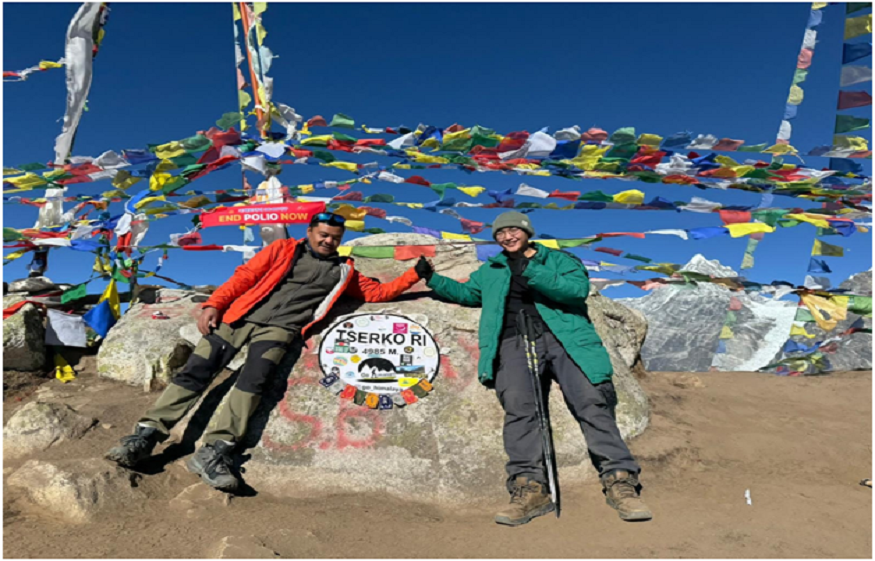When it comes to trekking in Nepal, names like Everest Base Camp and Annapurna Base Camp tend to overwhelm the highlight. But Nepal is farther than its postcard-famous peaks. Wander off the beaten path, and you’ll discover yourself inundated in untouched valleys, old societies, and scenes that extend the creative ability. Among these calm Himalayan ponders, four stand out as the gems of inaccessible trekking: the 5-Day Langtang Valley trek, the secretive Nar Phu Valley trek, the magnificent Manaslu Circuit trek, and the classic however challenging Annapurna Circuit trek. Each course offers a particular mix of crude nature, social genuineness, and profound enterprise that guarantees distance more than a physical trek—it’s an enthusiastic and otherworldly exploration.
The short but Sweet 5-Day Langtang Valley Trek
For trekkers short on time but tall on desire, the 5-days Langtang Valley trek is an idealized section into Nepal’s mountain world. Beginning a day’s drive from Kathmandu, the trek leads into Langtang National park, a region brimming with biodiversity and social profundity. In spite of being one of the closest treks to the capital, Langtang remains underappreciated, which as it were includes to its appeal.
The course regularly starts at Syabrubesi and passes through thick woodlands of bamboo and rhododendron, curious Tamang towns like Lama Lodging and Langtang Town, some time recently coming to Kyanjin Gompa, the otherworldly and beautiful highlight of the trek. Set underneath the towering Langtang Lirung (7,227m), Kyanjin offers clearing vistas and discretionary day climbs to Tserko Ri for all encompassing Himalayan views.
This shorter adaptation of the Langtang trek condenses the encounter into a tight but impactful bundle. You’ll pass cascading waterfalls, cross wooden suspension bridges, and witness the revamping of communities that were crushed amid the 2015 seismic tremor. The warmth of the Tamang individuals, their Buddhist conventions, and the peaceful magnificence of the valley make the Langtang trek a covered up masterpiece.
The Nar Phu Valley Trek
Remote, wild, and socially protected, the Nar Phu Valley trek is a trek into a diverse measurement of Nepal. Covered up in the rain shadow of the Annapurna run, the Nar and Phu valleys were confined to untouchables until 2002, protecting centuries of Tibetan Buddhist convention, fortress-like towns, and untouched wilderness.
The trek starts at Koto, close to Chame on the Annapurna Circuit, some time recently veering off into a rough scene of contract gorges, medieval towns, and high-altitude pastures. Phu Gaon, a medieval fortification town roosted at 4,080m, feels like a living exhibition hall with its stone structures, turning supplication wheels, and yak caravans. Advance on lies Nar Town, similarly true but more exuberant, particularly amid neighborhood festivals.
Between these two valleys lies the Kang La Pass (5,322m)—a breathtaking climb that rewards trekkers with all encompassing views of Annapurna II, Tilicho peak, and the encompassing Himalayas. The plummet leads back to the Annapurna Circuit, giving an epic juncture of two unmistakable trails.
Nar Phu is best for those looking for isolation, true culture, and a physical challenge. It’s not approximately tea shops and comfort—it’s almost crude Himalayan wild and old convention. Since the region is confined, an uncommon permit and an enrolled guide are obligatory, guaranteeing restricted activity and protected charm.
The Untamed Radiance of the Manaslu Circuit Trek
At the heart of Nepal’s inaccessible trekking story is the Manaslu Circuit Trek—an exceptional path circling Mount Manaslu (8,163m), the eighth-highest mountain in the world. Frequently depicted as what the Annapurna Circuit utilized to be 30 a long time prior, Manaslu offers both magnificence and elegance with distant less trekkers.
Beginning in Soti Khola, the path takes after the booming Budhi Gandaki Stream, passing through tropical woodlands, suspension bridges, and inaccessible Gurung and Tibetan towns. Each day climbs more profound into snow capped landscape, with eminent towns like Namrung, Lho, and Samagaon advertising impressions into Buddhist life with chortens, main dividers, and magnificent monasteries.
Samagaon serves as an acclimatization base and is a perfect spot to visit the sacrosanct Pungyen Gompa or climb up to the Manaslu Base Camp. Assisted ahead, Samdo gives a tour of the exchange courses to Tibet. The climax is crossing the Larkya La Pass (5,106m), a snow-covered col with mind-blowing sees of Himlung Himal, Cheo Himal, Kangguru, and Annapurna II.
Permits are required for this limited region, and enlisting an authorized guide is obligatory. Manaslu is perfect for prepared trekkers needing a genuine Himalayan experience—one where you can walk for hours without seeing another outsider and still feel drenched in sacrosanct land.
The Amazing Annapurna Circuit Trek
Although broadly known, the Annapurna Circuit trek remains a fulfilling path for those who select to do it the right way—away from the unused streets, with regard for its legacy, and at a pace that permits for full inundation. Once respected as the most prominent trek in the world, the circuit still has covered up privileged insights holding up to be discovered.
This trek starts in Besisahar and rapidly moves from lavish subtropical woodlands and rice patios to high-altitude deserts reminiscent of Tibet. As you rise, the societies alter from Hindu swamps to Buddhist good countries, advertising a wealthy embroidered artwork of religion, design, and lifestyle.
Highlights incorporate Pisang, with its medieval-style upper town, Manang, a culturally-rich acclimatization town encompassed by spiked peaks, and the challenging climb to Thorong La Pass (5,416m)—the most noteworthy point of the circuit. After the pass, the path slips to the Muktinath Sanctuary, a venerated location for both Hindus and Buddhists, and advances into Jomsom and Marpha, celebrated for their apple orchards.
The Annapurna Circuit is not a covered up pearl in the conventional sense, but when matched with side trails like Tilicho Lake, Upper Pisang, or Ghyaru, it becomes a mystery worth investigating. Trekkers ought to arrange around 14 to 18 days, and in spite of the fact that streets have come to a few parts, vital arranging can maintain a strategic distance from them.
Comparing the Trails: What Makes Each One Special?
Each of these treks—Langtang, Nar Phu, Manaslu, and Annapurna Circuit—offers something unique:
Langtang Valley (5 Days): Best for short treks, wealthy in culture and snow capped with negligible crowds.
Nar Phu Valley: A crude, magical, and rough trek into a region unaltered for centuries.
Manaslu Circuit: A long, wild travel through farther scenes, perfect for experienced trekkers.
Annapurna Circuit: A social mosaic with emotional view, tall passes, and wealthy variation.
All four treks take you distant from the commercialized trails of Nepal and into ranges where convention still holds influence. They offer a more individual, intelligent shape of trekking that changes the soul as much as it challenges the body.
Culture and Association on the Trails
What genuinely raises these treks is the chance to lock in with bona fide Himalayan culture. In Langtang, the Tamang individuals welcome you with chants, grins, and hand crafted yak cheese. In Nar and Phu, Tibetan Buddhist life is on full show with old cloisters and ageless traditions. Manaslu’s Gurung and Tibetan settlements offer otherworldly peace and mountain neighborliness, whereas the Annapurna region appears an assorted blend of Gurung, Thakali, and Manangi heritage.
This social assortment is what turns a trek into a life-changing travel. It’s not fair the mountains you come to see, but the individuals who live among them—their strength, liberality, and otherworldly profundity leave an enduring impression.
Nature, Natural life, and Conservation
These treks pass through a few of Nepal’s most imperative preservation areas:
Langtang National park: Domestic to ruddy pandas, Himalayan dark bears, and over 250 species of birds.
Annapurna Preservation Range (ACAP): Nepal’s biggest secured region, enveloping assorted environments from subtropical to alpine.
Manaslu Preservation Zone (MCAP): Made to protect the delicate biodiversity and advance eco-tourism.
Spring (March–May) and harvest time (September–November) are perfect seasons, advertising sprouting rhododendrons, fresh seeds, and less weather-related disturbances. Eco-conscious trekking is exceedingly encouraged—use reusable water bottles, dodge plastic, and back nearby teahouses that utilize maintainable practices.
Planning Your Inaccessible trek in Nepal
- Permits and planning are crucial for trekking in these inaccessible regions:
- Langtang Valley: TIMS card and Langtang National park permit.
- Nar Phu Valley: Confined Zone Allow (RAP), ACAP, TIMS, and an authorized guide.
- Manaslu Circuit: RAP, MCAP, ACAP, and an authorized guide.
- Annapurna Circuit: ACAP and TIMS only.
- Pack layers, as climate can move rapidly. Bring fundamentals like a quality down coat, waterproof adapter, a great resting sack, water refinement tablets, and a control bank. A wellness base makes a difference, but mental strength and regard for nearby traditions are fair as crucial.
Conclusion:
Nepal’s inaccessible trails—Langtang, Nar Phu, Manaslu, and Annapurna—are not fair trekking courses. They are helps that interface the advanced traveler to the antiquated, the normal, and the sacrosanct. These treks bypass the Instagram circuits and dig into a world where time is stamped not by clocks but by supplication wheels, dawn over the mountains, and the sound of wind whispering through pine forests.
To trek these covered up ways is to strip absent diversions and walk into the heart of Nepal, one step at a time. In doing so, you don’t fairly reach a physical destination—you rediscover something inside yourself: stillness, point of view, and awe.
FAQs
Is the 5-day Langtang trek reasonable for beginners?
Yes, it’s one of the best beginner-friendly treks advertising extraordinary views and culture in a short timeframe.
What makes Nar Phu Valley unique?
It’s greatly farther and untouched, protecting Tibetan Buddhist culture and advertising tall mountain views without the crowds.
How difficult is the Manaslu Circuit Trek?
It’s decently to exceptionally challenging due to long days and elevation but doable with great wellness and acclimatization.
Can I do the Annapurna Circuit without a guide?
Yes, in spite of the fact that having a guide upgrades security and social knowledge. A few zones presently have streets to get to, so arrange temporary routes accordingly.
What’s the best season for these treks?
Spring (March–May) and harvest time (September–November) offer the best climate, clear skies, and perfect path conditions.
Company address: Everest Trekking Routes Pvt. Ltd.
16 Khumbu, Nayabazaar, Kathmandu, Nepal
Mobile : +977-9843467921 (Rabin)
Email: [email protected]
URL:- www.everesttrekkingroutes.com

